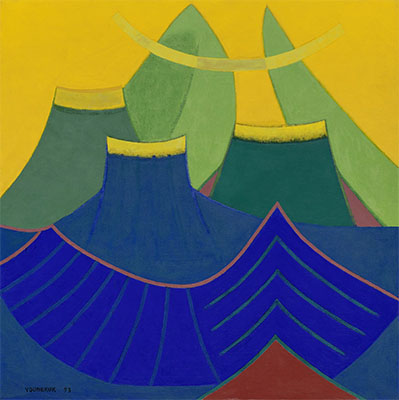유영국 뉴욕 페이스갤러리 개인전 'Yoo Youngkuk: Mountain Within' (11/10-12/22)
Yoo Youngkuk: Mountain Within
November 10 – December 22, 2023
540 West 25th Street, New York

Yoo Youngkuk, Work, 1973 © Yoo Youngkuk Art Foundation, courtesy Pace Gallery
New York – Pace is pleased to present an exhibition of paintings by Yoo Youngkuk, a hugely influential 20th century Korean abstractionist, at its 540 West 25th Street gallery in New York. On view from November 10 to December 22, this show, titled Mountain Within, will mark the first-ever solo presentation of Yoo’s work outside Korea.
Born in 1916 in Uljin, South Korea, Yoo was a pioneer of geometric abstract painting. His distinctive visual lexicon is characterized by bold color fields and expressive applications of paint. With his unique approach to color, form, and space, Yoo took up a steadfast and passionate investigation of his personal relationship with nature, capturing the majesty of the natural world—particularly the varied landscape of Uljin—through acts of painterly distillation that
would lean increasingly into abstract territory.
Yoo began studying painting under artist Murai Masanari at Bunka Gakuin University in Tokyo in 1935, nurturing his interest in abstraction and making a name for himself in the Japanese art world. He returned to Korea in 1943, and the next decade of his life and career would be punctuated by several historic crises, including the Pacific War of World War II and the Korean War. During periods of relocation and prolonged breaks from painting precipitated by these upheavals, Yoo’s commitment to his artistic practice never wavered.
Political and social turmoil played a significant role in shaping the artist’s worldview, which was marked by an appreciation for and deep understanding of the fragility of life. His first-hand experiences of such chaos led him to adopt mountain-like forms—symbols of stability and endurance—as recurring motifs in his paintings.
“As his nation struggled to rise from the ashes of war, he felt that abstract art, with its rejection of pathos, could be the embodiment of the new life and art of Korea,” Kim Inhye, curator at the National Museum of Modern and Contemporary Art (MMCA) in Korea, wrote in Rizzoli’s 2020 monograph on Yoo.
Marking Yoo’s first exhibition with Pace since the gallery began representing his estate in the US and Europe earlier this year, the upcoming presentation of the artist’s work in New York will include a selection of richly hued paintings created between 1965 and 1995, with a focus on his practice during the 1960s. During this decade, the artist pursued a formal demarcation of space in his compositions, creating lyrical, nuanced plays of color and form, both geometric and biomorphic. Paintings from the 1980s and 1990s featured in the exhibition offer viewers a look at the artist’s later career, when, despite prolonged health struggles, his abstractions took on greater dynamism and crispness than previous decades. Together, the vibrant, luminous works in this landmark presentation will speak to Yoo’s lifelong belief in the spiritual and poetic power of abstraction—he often said that he was in pursuit of “absolute freedom”
through his painting practice.
Yoo, who died in 2002, left an indelible mark on the history of art in Korea. He helped form several avant-garde groups in the country in the 1950s and 1960s, including the Modern Art Association, the Contemporary Artists, and New Figures, but his legacy extends beyond the country’s modernist movement and remains deeply felt in the country’s cultural and aesthetic fabric today.
Despite Yoo’s prominence in Korean art history, his practice is lesser known to international audiences. In 2016, the centenary of Yoo’s birth, a retrospective of his work was presented at the National Museum of Modern and Contemporary Art in Seoul and the Busan Museum of Art. Pace’s forthcoming presentation of his work will be the artist’s first-ever solo show in New York and, more broadly, the United States.
Throughout his nearly seven-decade career, Yoo Youngkuk (b. 1916, Uljin-gun, South Korea; d. 2002, Seoul, South Korea) founded several vital artistic groups in Japan and Korea that blazed a trail for generations of avant-garde artists. A pioneer of geometric abstract painting, his distinctive visual lexicon is characterized by bold color fields and an expressive application of paint. At the core of Yoo’s practice is a steadfast and passionate engagement with the distillation of painterly forms as a means of investigating his deeply personal relationship to nature.
As a young man, becoming a painter represented a kind of freedom for Yoo. It opened the door to communities of like-minded artists and offered an outlet for his rich inner world. Experimenting with an array of materials and techniques, including wood relief, photography, and painting, early influences of Russian Constructivism, Suprematism, and Neo-Plasticism are keenly felt in Yoo’s work. Regardless of the material, the artist’s use of color, form, and space expertly captured the brilliance and majesty of nature while maintaining a distinctly abstract sensibility.
Yoo’s life was punctuated by multiple historic upheavals, including World War II and the Korean War. These periods of crisis enforced relocation and prolonged breaks from painting, but only strengthened Yoo’s commitment to his artistic practice. His unwavering dedication garnered significant critical engagement and several major institutional exhibitions across Korea. Against the fragility of daily life caused by the turmoil of global conflict, mountains became a signature motif in the artist’s paintings, serving as symbols of stability and endurance. Art historian and curator Dr.
Gabriel Ritter explained, ‘For Yoo, the rocky summit of Mount Seoraksan and the tree-covered Taebaek mountain range were to become the embodiment of nature and Korea itself, and a constant.





